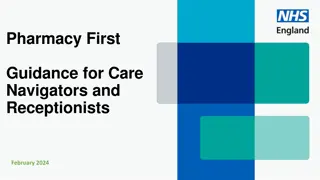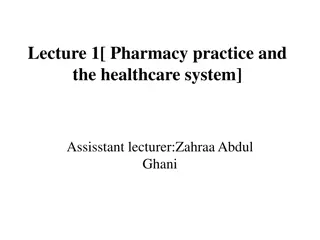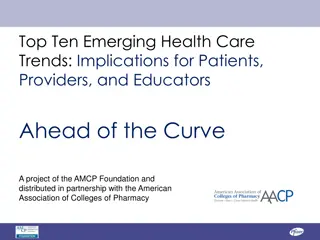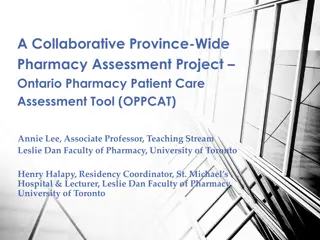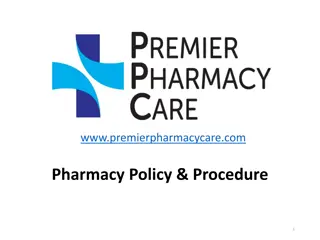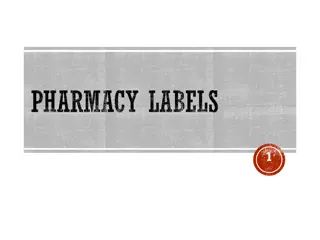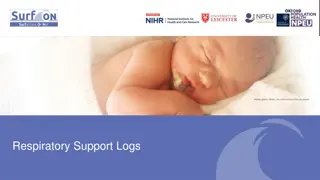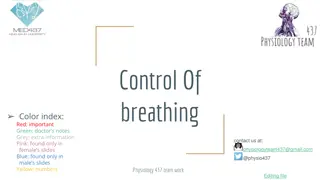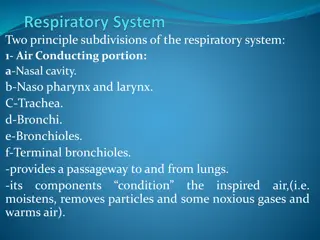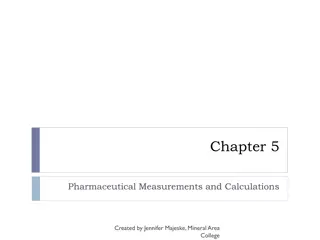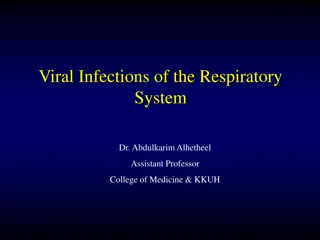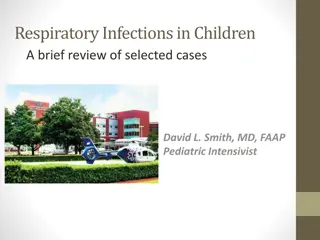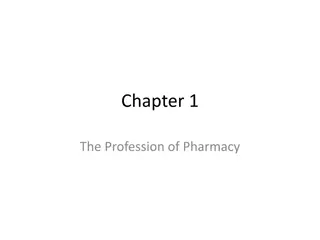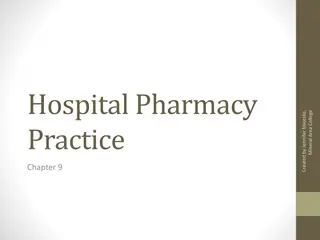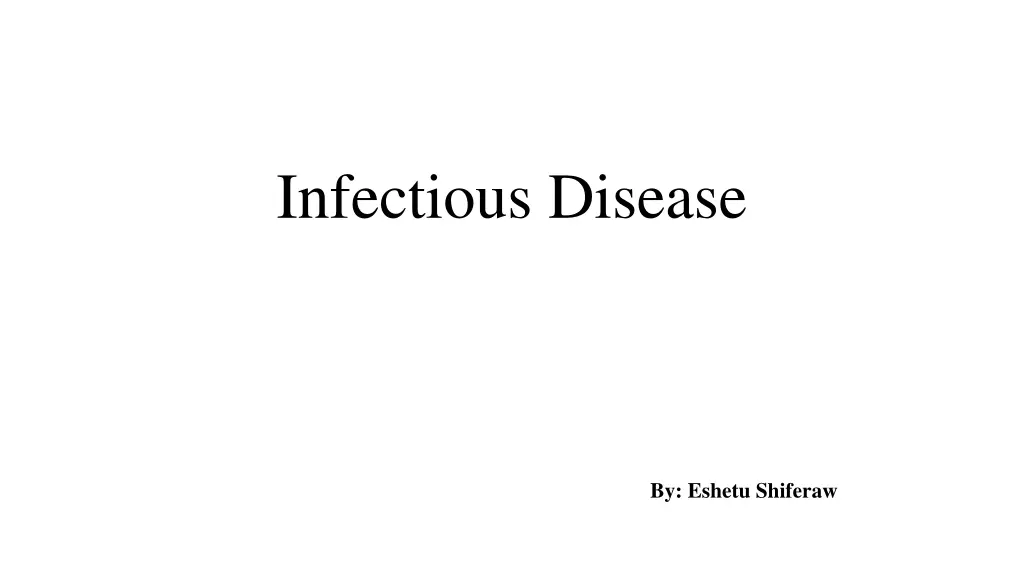
Understanding Infectious Disease and Colonization Versus Infection
Explore the differences between colonization and infection, learn about pathogens, antimicrobial regimen selection, signs of infection, and more in the context of infectious diseases. Discover how to confirm the presence of infection and select appropriate therapy.
Download Presentation

Please find below an Image/Link to download the presentation.
The content on the website is provided AS IS for your information and personal use only. It may not be sold, licensed, or shared on other websites without obtaining consent from the author. If you encounter any issues during the download, it is possible that the publisher has removed the file from their server.
You are allowed to download the files provided on this website for personal or commercial use, subject to the condition that they are used lawfully. All files are the property of their respective owners.
The content on the website is provided AS IS for your information and personal use only. It may not be sold, licensed, or shared on other websites without obtaining consent from the author.
E N D
Presentation Transcript
Infectious Disease By: Eshetu Shiferaw
COLONIZATION VERSUS INFECTION Infection refers to the presence of bacteria that are causing disease (e.g., the organisms are found in normally sterile anatomic sites or in nonsterile sites with signs/symptoms of infection). Colonization refers to the presence of bacteria that are not causing disease. Many areas of the human body are colonized with bacteria normal flora. Infections often arise from one s own normal flora endogenous infection. Endogenous infection may occur when: There are alterations in the normal flora (e.g., recent antimicrobial use may allow for overgrowth of other normal flora) or Disruption of host defenses (e.g., a break or entry in the skin).
Pathogens are organisms that are capable of damaging host tissues and that elicit specific host responses and symptoms that are consistent with an infectious process. These organisms are transferred from patient to patient, vector to patient (animals, insects, and so on),environment to patient (e.g., hospital settings) or are derived from the patient s own flora. Conversely, the human body contains a vast variety of microorganisms that colonize body systems and make up the so-called normal flora. These organisms occur naturally in the tissues of the host and provide some benefits, including defense by occupying space, competing for essential nutrients, Stimulating cross-protective antibodies, and suppressing the growth of potentially pathogenic bacteria and fungi Organisms that comprise the normal flora can become pathogenic when host defenses become impaired or if they are translocated
Antimicrobial Regimen Selection CONFIRMING THE PRESENCE OF INFECTION FEVER-Fever is defined as a controlled elevation of body temperature above the normal range. The presence of a temperature greater than the expected 37 C (98.6 F) normal body temperature is considered a hallmark of infectious diseases. Body temperature is controlled by the hypothalamus. The use of antipyretics should be discouraged during the treatment of infection unless absolutely necessary
SIGNS White Blood Cell Count Most infections result in elevated WBC counts (leukocytosis) because of the increased production and mobilization of granulocytes (neutrophils, basophils, and eosinophils), lymphocytes, or both to ingest and destroy invading microbes Local Signs The classic signs of pain and inflammation can manifest as swelling, erythema, tenderness, and purulent drainage. But not for deep-seated infections
SELECTION OF PRESUMPTIVE THERAPY To select rational antimicrobial therapy for a given clinical situation, a variety of factors must be considered. These include the : severity and acuity of the disease, host factors, factors related to the drugs used, and the necessity for using multiple agents. HOST FACTORS Several host factors should be considered when evaluating a patient for antimicrobial therapy. The most important factors are drug allergies, age, pregnancy, genetic or metabolic abnormalities, renal and hepatic function, site of infection, concomitant drug therapy, and underlying disease states.
DRUG FACTORS Integration of both pharmacokinetic and pharmacodynamics properties of an agent is important when choosing antimicrobial therapy to ensure efficacy and to prevent resistance. e . g Aminoglycosides exhibit concentration-dependent bactericidal effects. Tissue Penetration The importance of tissue penetration varies with site of infection. An example of the latter difficulty is with penetration to deep infections, such as abscesses, where various factors such as acid pH, WBC products, and various enzymes can inactivate even high concentrations of certain drugs Body fluids where drug concentration data are clinicaly relevant include: oCSF, urine, synovial fluid, and peritoneal fluid
Drug Toxicity: CAF-bone marrow suppression, trimitoprim-megaloblastic anemia, aminoglycoside-ototoxicity Cost COMBINATION ANTIMICROBIAL THERAPY In selecting a drug regimen for a given patient, consideration must be given to the necessity of using more than one drug. Combinations of antimicrobials generally are used to a. broaden the spectrum of coverage for empirical therapy, b. achieve synergistic activity against the infecting organism, and c. prevent the emergence of resistance especially in TB treatment.
Disadvantages of Combination Therapy Although there are potentially beneficial effects from combining drugs, there also are potential disadvantages, including: increased cost, increased greater risk of drug toxicity such as nephrotoxicity Also The combination of two or more antibiotics can result in antagonistic effects
Lower Respiratory Tract Infections Respiratory tract infections remain the major cause of morbidity from acute illness in the United States and most likely represent the single most common reason patients seek medical attention. The respiratory tract has an elaborate system of host defenses, including humoral immunity, cellular immunity, and anatomic mechanisms. When functioning properly, the host defenses of the respiratory tract are markedly effective in protecting against pathogen invasion and removing potentially infectious agents from the lungs. For the most part, infections in the lower respiratory tract occur only when these defense mechanisms are impaired
The most common infections involving the lower respiratory tract are bronchitis, bronchiolitis, and pneumonia. Lower respiratory tract infections in children and adults most commonly result from either viral or bacterial invasion of lung parenchyma.
BRONCHITIS Bronchitis and bronchiolitis are inflammatory conditions of the large and small elements, respectively, of the tracheobronchial tree. The inflammatory process does not extend to the alveoli. Bronchitis frequently is classified as acute or chronic. Acute bronchitis occurs in individuals of all ages, whereas chronic bronchitis primarily affects adults. Bronchiolitis is a disease of infancy. ACUTE BRONCHITIS Epidemiology and Etiology Acute bronchitis occurs most commonly during the winter months, following a pattern similar to those of other acute respiratory tract Respiratory viruses are by far the most common infectious agents associated with acute bronchitis.
rhinovirus and coronavirus) and influenza virus and adenovirus) account for the majority of cases Mycoplasma pneumonia frequent cause of acute bronchitis Chlamydia pneumonia and Bordetella Pertussis responsible for whooping cough
Pathogenesis Because acute bronchitis is primarily a self-limiting illness and rarely a cause of death, few data describing the pathology are available. In general, infection of the trachea and bronchi yields hyperemic and edematous mucous membranes with an increase in bronchial secretions. Destruction of respiratory epithelium can range from mild to extensive and may affect bronchial mucociliary function. In addition, the increase in bronchial secretions, which can become thick and tenacious, further impairs mucociliary activity. The probability of permanent damage to the airways as a result of acute bronchitis remains unclear; however, epidemiologic evaluations support the belief that recurrent acute respiratory infections may be associated with increased airway hyperreactivity and possibly the pathogenesis of asthma or chronic obstructive pulmonary disease (COPD).
Clinical Presentation Acute bronchitis usually begins as an upper respiratory infection with nonspecific complaints Cough is the hallmark of acute bronchitis and occurs early. The onset of cough may be insidious or abrupt, and the symptoms persist despite resolution of nasal or nasopharyngeal complaints. Frequently, the cough initially is nonproductive but then progresses, yielding mucopurulent sputum. Signs and symptoms Cough persisting >5 days to weeks Coryza, sore throat, malaise, headache, Fever rarely >39 C Physical examination Rhonchi or coarse, moist, bilateral rales Purulent sputum in ~50% of patients Chest radiograph Normal
Bacterial cultures of expectorated sputum generally are of limited use because of the inability to avoid normal nasopharyngeal flora by the sampling technique. In routine cases, viral cultures are unnecessary and frequently unavailable. DIFFERENTIAL DIAGNOSIS Chronic bronchitis Pneumonia Gastroesophageal reflux Asthma
TREATMENT Acute Bronchitis GENERAL APPROACH TO TREATMENT: Treatment of acute bronchitis is symptomatic and supportive in nature. Bed rest for comfort may be instituted drink fluids to prevent dehydration and possibly to decrease the viscosity of respiratory secretions. Mist therapy (use of a vaporizer) may promote the thinning and loosening of respiratory secretions.
PHARMACOLOGIC THERAPY: Mild analgesic antipyretic therapy for symptomatic relief Patients suffering from acute bronchitis frequently medicate themselves with nonprescription cough and cold remedies containing various combinations of: antihistamines, sympathomimetic, and antitussives despite the lack of definitive evidence supporting their effectiveness. In fact, the tendency of these agents to dehydrate bronchial secretions could aggravate and prolong the recovery process. Routine use of antibiotics for treatment of acute bronchitis should be discouraged.
But In previously healthy patients who exhibit: persistent fever or respiratory symptoms for more than 4 to 6 days or in predisposed patients (e.g., elderly, immunocompromised), the possibility of a concurrent bacterial infection should be suspected. When possible, antibiotic therapy should be directed toward anticipated respiratory pathogen (eg s.pneumonia)
CHRONIC BRONCHITIS Epidemiology and Etiology Chronic bronchitis is a nonspecific disease that primarily affects adults. Chronic bronchitis occurs more commonly in men than in women Chronic bronchitis is a result of several contributing factors; the most prominent include: cigarette smoking, exposure to occupational dusts, fumes, and environmental pollution; and host factors (e.g., genetic factors and bacterial [and possibly viral] infections).
Pathogenesis: Chronic inhalation of an irritating noxious substance compromises the normal secretory and mucociliary function of bronchial mucosa. In chronic bronchitis, the bronchial wall is thickened, and the number of mucus- secreting goblet cells on the surface epithelium of both larger and smaller bronchi is increased markedly. In contrast, goblet cells generally are absent from the smaller bronchi of normal individuals. In addition to the increased number of goblet cells, hypertrophy of the mucous glands and dilation of the mucous gland ducts are observed. As a result of these changes, chronic bronchi tics have substantially more mucus in their peripheral airways, further impairing normal lung defenses. This increased quantity of tenacious secretions within the bronchial tree frequently causes mucous plugging of the smaller airways
Continued progression of this pathology can result in residual scarring of small bronchi and peribronchial fibrosis augmenting airway obstruction and weakening of bronchial walls. Clinical Presentation: The hallmark of chronic bronchitis is a cough that may range from a mild smoker s cough to severe, incessant coughing productive of purulent sputum. The diagnosis of chronic bronchitis is based primarily on clinical assessment and history. Any patient who reports coughing sputum on most days for at least 3 consecutive months each year for 2 consecutive years presumptively has chronic bronchitis.
TREATMENT Chronic Bronchitis GENERAL APPROACH TO TREATMENT: The approach to treatment of chronic bronchitis is multifactorial. First and foremost, attempts must be made to reduce the patient s exposure to known bronchial irritants (e.g., smoking, workplace pollution). PHARMACOLOGIC THERAPY: For patients who consistently demonstrate clinical limitation in airflow, a therapeutic challenge of 2-agonist bronchodilators (e.g., as albuterol aerosol) should be considered. Pulmonary function tests can be performed Oral antibiotics with broader antibacterial spectra (e.g., amoxicillin clavulanate, fluoroquinolones, ) that possess more potent in-vitro activity against sputum isolates are increasingly becoming first-line antibiotics as initial therapy for treatment of acute exacerbations of chronic bronchitis
Antibiotic Usual AdultDose (g) Dose Schedule (doses/day) Ampicillin 0.25 0.5 4 Amoxicillin 0.5 0.875 3 2 Amoxicillin clavulanate 0.5 0.875 Ciprofloxacin 0.5 0.75 2 Levofloxacin 0.5 0.75 Moxifloxacin 0.4 1 Doxycycline 0.1 2 Minocycline 0.1 Tetracycline HCl 0.5 4 Trimethoprim-sulfamethoxazole a 1 DS 2 3 2 1 2
PNEUMONIA Pneumonia is an infection of the pulmonary parenchyma. To the pathologist, pneumonia is an infection of the alveoli, distal airways, and interstitium of the lung that is manifested by: increased weight of the lungs, Replacement of normal lung s sponginess by consolidation, and Alveoli filled with white blood cells, red blood cells and fibrin. EPIDEMIOLOGY: Pneumonia is the most common infectious cause of death in the United States. Pneumonia is a leading cause of death worldwide, the sixth leading cause of death in the United States, and the most common lethal infectious disease. Pneumonia occurs throughout the year, with the relative prevalence of disease resulting from different etiologic agents varying with the seasons.
ETIOLOGy 1.Infections 2.Inhalation of gastric contents 3.Immunological reactions 4.Inhalation of other toxic substances Classification: 1.Community-acquired pneumonia (CAP) includes - Cases of infectious pneumonia in patients living independently in the community - Patients who have been hospitalized for other reasons for less than 48 hours before the development of respiratory symptoms
2.Health careassociated pneumonia (HCAP) -Patients who have previously been hospitalized for at least 2 days within the 90 days before infection -Patients from nursing homes who received intravenous antibiotic therapy, chemotherapy, or wound care within the past 30 days -Patients from haemodialysis centers -Patients contracting pneumonia greater than 48 hours after the institution of endotracheal intubation and mechanical ventilation a. Hospital-acquired pneumonia (HAP) b. Ventilator-associated pneumonia (VAP)
PATHOGENESIS:Microorganisms gain access to the lower respiratory tract by three routes. They may be : inhaled as aerosolized particles, or they may enter the lung via the bloodstream from an extra pulmonary site of infection; however, aspiration of oropharyngeal contents, a common occurrence in both healthy and ill persons during sleep, is the major mechanism by which pulmonary pathogens gain access to the normally sterile lower airways and alveoli. Penetrating chest trauma Local spread from contagious site
What are the host defence mechanisms? A. mechanical factors - Hairs and turbinates of the nares & airway cilia -The gag reflex and -The cough mechanism B. Cellular immunity -Alveolar macrophage and neutrophils C. Humoral immunity - IgG and IgA
The most prominent pathogen causing community-acquired pneumonia in otherwise healthy adults is S. pneumoniae (pneumococcus) and accounts for up to 75% of all acute cases. Other common pathogens include M. pneumoniae, Legionella, C. pneumoniae, H. influenzae, and a variety of viruses including influenza. Community acquired pneumonias caused by Staphylococcus aureus and gram negative rods are observed primarily in the elderly, especially those residing in nursing homes, and in association with alcoholism and other debilitating conditions. The term atypical may be applied to pneumonia to indicate that the pneumonia may be caused by an atypical pathogen. Although this older terminology is slowly fading, atypical pneumonia or atypical pathogens refers to pneumonia (e.g. bilateral lobar pneumonia with a negative Gram stain of sputum) caused by M. pneumoniae, C. pneumoniae, or Legionella.
Anaerobic bacteria are the most common etiologic agents in pneumonia that follows the gross aspiration of gastric or oropharyngeal contents Most pneumonias occurring in the pediatric age group are caused by viruses, especially RSV, parainfluenza, and adenovirus. M. pneumoniae is an important pathogen in older children. CLINICAL PRESENTATION Bacterial Pneumonia The complete blood count usually reflects a leukocytosis with a predominance of polymorphonuclear cells; in some instances, particularly with pneumococcus, elevation of the white blood cell (WBC) count may be pronounced
Signs and symptoms Abrupt onset of fever, chills, dyspnea, and productive cough Rust-colored sputum or hemoptysis Pleuritic chest pain Physical examination Tachypnea and tachycardia Dullness to percussion Increased tactile fremitus, whisper pectoriloquy, and egophony Chest wall retractions and grunting respirations Diminished breath sounds over affected area Inspiratory crackles during lung expansion Chest radiograph Dense lobar or segmental infiltrate Laboratory tests Leukocytosis with predominance of polymorphonuclear cells Low oxygen saturation on arterial blood gas or pulse oximetry
DIFFERENTIAL DIAGNOSIS Acute bronchitis Acute exacerbations of chronic bronchitis, Heart failure Pulmonary embolism
Treatment The principles of treatments are supportive care of the patient like oxygen , hydration To treat non complicated pneumonia as outpatient and complicated pneumonia and severely ill patients as inpatients To kill the organism with appropriate antibiotics To recognize and treat complications
Multiple factors that help to define the potential pathogens involved include: patient age, previous and current medication history, Underlying disease(s), major organ function, and present clinical status
Empirical Antimicrobial Therapy for Pneumonia in Adults Clinical Setting Usual Pathogen(s) Presumptive Therapy Previously healthy ambulatory patient Pneumococcus, Mycoplasma pneumonia Pneumococcus, gram negative bacilli (e.g., Klebsiella pneumoniae); Staphylococcus aureus, Haemophilus influenzae Macrolide/azalide, tetracycline Piperacillin tazobactam, cephalosporin, carbapeneme Chronic bronchitis Pneumococcus, H. influenzae, M. catarrhalis Amoxicillin, tetracycline, trimethoprimsulfamethoxazole, cefuroxime,amoxicillinclavulanat e,macrolide/azalide,fluoroquino lone Aspiration Community Hospital/residential care Mouth anaerobes, S. aureus, gram-negative enterics PenicillinorClindamycin,ticarcilli nclavulanate,piperacillintazobac tam, plusaminoglycoside Nosocomial pneumonia Gram-negative bacilli (e.g., K. pneumoniae,Enterobacterspecie s, Pseudomonas aeruginosa), S. Piperacillintazobactam,carbapen em or extended spectrum cephalosporinplusaminoglycosid
Community-Acquired Pneumonia 1.Outpatients: Previously healthy and no antibiotics in past 3 months A macrolide [clarithromycin 500 mg tablets twice daily for five days or until afebrile for 48 to 72 hours or azithromycin 500 mg a day for three days] or Doxycycline 100 mg twice a day for 7 to 10 days Comorbidities or antibiotics in past 3 months: A respiratory fluoroquinolone(gemifloxacin 320 mg daily, levofloxacin 750 mg daily, or moxifloxacin 400 mg daily) for a minimum of five days. A -lactam (high-dose amoxicillin or amoxicillin/clavulanate or ceftriaxone or cefuroxime) plus a macrolide azithromycin is preferred for outpatients with comorbidities such as chronic obstructive pulmonary disease
2.Inpatients, non-ICU A respiratory fluoroquinolone [moxifloxacin, gemifloxacin, levofloxacin] or A -lactam [cefotaxime, ceftriaxone, ampicillin] plus a macrolide [clarithromycin or azithromycin] 3.Inpatients, ICU A -lactam [cefotaxime, ceftriaxone, ampicillin-sulbactam] PLUS azithromycin or a fluoroquinolone
Generally Treatment regimens for outpatients with community-acquired pneumonia (CAP) are based upon the severity of illness, the presence of comorbid conditions, and the prevalence of risk factors for drug resistant S. pneumonia No comorbidities or recent antibiotic use: For uncomplicated pneumonia in patients who do not require hospitalization, have no significant comorbidities and/or use of antibiotics within the last three months, Azithromycin (500 mg on day one followed by four days of 250 mg a day); 500 mg a day for three days, Clarithromycin (two 500 mg tablets once daily) for five days or until afebrile for 48 to 72 hours Doxycycline (100 mg twice a day) for 7 to 10 days
Comorbidities or recent antibiotic use The presence of significant comorbidities (ie, chronic obstructive pulmonary disease [COPD], liver or renal disease, cancer, diabetes, chronic heart disease, alcoholism, asplenia, or immunosuppression), and/or use of antibiotics within the prior three months, A respiratory fluoroquinolone ( gemifloxacin 320 mg daily, levofloxacin 750 mg daily, or moxifloxacin 400 mg daily) for a minimum of five days. Combination therapy with a beta-lactam effective against S. pneumoniae ( high-dose amoxicillin , 1 g three times daily or amoxicillin-clavulanate 2 g twice daily or cefpodoxime 200 mg twice daily or cefuroxime 500 mg twice daily) ( azithromycin 500 mg on day one followed by four days of 250 mg a day or clarithromycin 250 mg twice daily or clarithromycin XL 1000 mg once daily) or doxycycline (100 mg twice daily). Treatment should be continued for a minimum of five days PLUS either a macrolide
INDICATIONS FOR HOSPITALIZATION C onfusion (based upon a specific mental test or disorientation to person, place, or time) U rea (blood urea nitrogen) >7 mmol/L (20 mg/dL) R espiratory rate >30 breaths/minute B lood pressure [BP] (systolic <90 mmHg or diastolic <60 mmHg) Age > 65 years
HAP and VAP Empiric coverage for patients WITHOUT risk factors for MDR pathogens For empiric coverage of HAP and VAP in patients with no known risk factors for MDR pathogens, we suggest one of the following intravenous antibiotic regimens: Ceftriaxone (2 g intravenously daily) Ampicillin-sulbactam (3 g intravenously every six hours) Levofloxacin (750 mg intravenously daily) or moxifloxacin (400 mg intravenously daily). When the patient is able to take oral medications, either agent may be administered orally at the same dose as that used for IV administration.
Empiric coverage for patients WITH risk factors for MDR pathogens For empiric coverage of HAP, VAP, and HCAP in patients with known risk factors for MDR pathogens, we recommend empiric combination therapy including: Antipseudomonal cephalosporin such as cefepime (2 g intravenously every eight hours) or ceftazidime (2 g intravenously every eight hours) Antipseudomonal carbapenem such as imipenem (500 mg intravenously every six hours) or meropenem (1 g intravenously every eight hours) or doripenem (500 mg intravenously every eight hours; administered over one hour for HAP or HCAP, administered over four hours for VAP) Piperacillin-tazobactam (4.5 g intravenously every six hours) PLUS Antipseudomonal fluoroquinolone, such as ciprofloxacin (400 mg intravenously every eight hours) or levofloxacin (750 mg intravenously daily). Aminoglycoside such as gentamicin or tobramycin (7 mg/kg intravenously once daily) or amikacin (20 mg/kg intravenously once daily). The aminoglycoside can be stopped after five to seven days in responding patients. PLUS :Linezolid (600 mg intravenously every 12 hours; may be administered orally when the patient is able to take oral medications) Vancomycin (15 to 20 mg/kg [based on actual body weight] intravenously every 8 to 12 hours for patients with normal renal function
COMPLICATIONS Respiratory failure Shock and multiorgan failure Exacerbation of comorbid illnesses Metastatic infection (e.g., brain abscess or endocarditis) Lung abscess Complicated pleural effusion (Empyema)
FOLLOW UP Fever and leukocytosis usually resolve within 2 and 4 days, respectively . Physical findings may persist longer. Chest radiographic abnormalities are slowest to resolve and may require 4 12 weeks to clear.
Upper Respiratory Tract Infections Upper respiratory tract infections include otitis media, sinusitis, pharyngitis, laryngitis (croup), rhinitis, and epiglottitis. Most nonspecific upper respiratory tract infections have a viral, not bacterial, etiology and tend to resolve spontaneously This chapter focuses primarily on otitis media, sinusitis, and pharyngitis because these infectious entities are frequently bacterial in origin, and appropriate antibiotic treatment can minimize morbidity and potentially prevent complications.
OTITIS MEDIA Otitis media is an inflammation of the middle ear manifests clinically as one or more of the following: Otalgia (denoted by pulling of the ear in some infants) Hearing loss Fever Irritability Risk factors for bacterial otitis media caused by resistant pathogens include (a) day-care attendance, (b) recent antibiotic exposure, (c) age younger than 2 years, and (d) frequent bouts of otitis media
PATHOPHYSIOLOGy Acute bacterial otitis media usually follows a viral upper respiratory tract infection that causes eustachian tube dysfunction and mucosal swelling in the middle ear. Bacteria that colonize the nasopharynx thus enter the middle ear and are not cleared properly by the mucociliary system. In the presence of effusion, the bacteria proliferate and cause infection. Children tend to be more susceptible to otitis media than adults S. pneumoniae is the most common bacterial cause of acute otitis media, with an incidence of 20% to 35%. Haemophilus influenzae and Moraxella catarrhalis are each responsible for 20% to 30% and 20% of cases, respectively
CLINICAL PRESENTATION General The acute onset of signs and symptoms of middle ear infection following cold symptoms of runny nose, nasal congestion, or cough Signs and symptoms Pain that can be severe (more than 75% of patients) Children may be irritable, tug on the involved ear, and have difficulty sleeping Fever is present in less than 25% of patients and, when present, occurs more often in younger children Examination shows a discolored (gray), thickened, bulging eardrum Pneumatic otoscopy or tympanometry demonstrates an immobile eardrum; 50% of cases are bilateral Draining middle ear fluid occurs (less than 3% of patients) that usually reveals a bacterial etiology Laboratory tests Gram stain, culture, and sensitivities of draining fluid or aspirated fluid if tympanocentesis is performed.
TREATMENT Acute Otitis Media: NONPHARMACOLOGIC THERAPY- Surgical insertion of tympanostomy tubes (T tubes) is an effective method for the prevention of recurrent otitis media. Children with recurrent otitis who have more than three episodes in 6 months or four or more episodes (one of which is recent) in a year should be considered for T-tube placement. PHARMACOLOGIC THERAPY-Acute otitis media must be distinguished from otitis media with effusion. Acetaminophen or a non steroidal anti inflammatory drug (NSAID) such as ibuprofen should be offered early to relieve pain and malaise Antimicrobials are indicated only in the former unless the effusion persists beyond 3 months in otitis media with effusion. Amoxicillin is the drug of choice for acute otitis media. High dose amoxicillin (80 to 90 mg/kg per day) is recommended If treatment failure occurs with amoxicillin, an agent should be chosen with activity against - lactamase producing H. influenza and M. catarrhalis, as well as drug-resistant S. pneumoniae.


